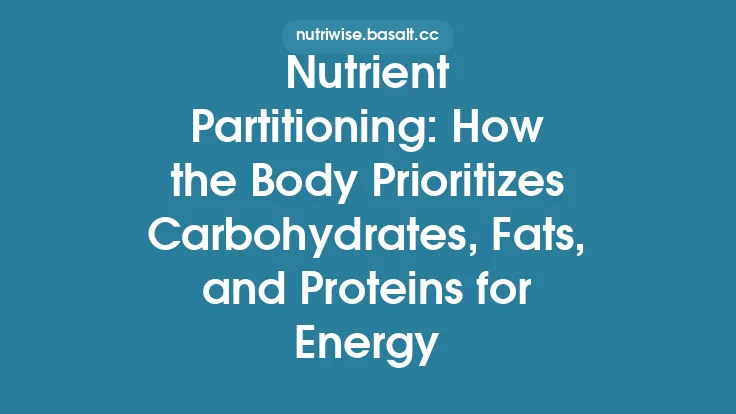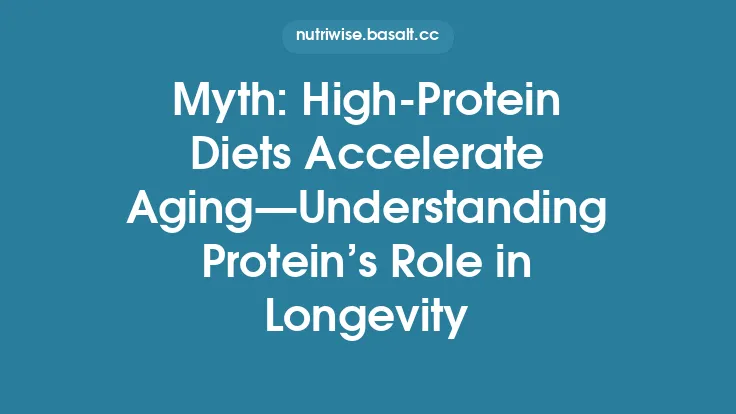Protein is the most versatile macronutrient in the human body, serving as the structural framework, the catalyst for countless biochemical reactions, and the messenger that coordinates cellular activity. While many people recognize protein as a dietary component, its true significance lies in the intricate ways it underpins virtually every physiological process. This article delves into the fundamental science of protein, exploring its chemical makeup, the diverse roles it plays within the body, and the mechanisms that regulate its synthesis and turnover. By understanding these core concepts, readers can appreciate why protein is often described as the “building blocks of the body” and how it contributes to health across the lifespan.
The Chemical Foundations of Protein
Proteins are polymers composed of repeating units called amino acids, linked together by peptide bonds. Each peptide bond forms through a condensation reaction that joins the carboxyl group of one amino acid to the amino group of the next, releasing a molecule of water. The resulting chain—known as a polypeptide—exhibits a repeating backbone of –N–Cα–C– atoms, with side chains (R groups) projecting from the α‑carbon.
The chemical properties of these side chains dictate how a protein folds, interacts with other molecules, and performs its function. Side chains can be non‑polar (hydrophobic), polar uncharged, positively charged (basic), or negatively charged (acidic). The distribution of these groups along the polypeptide chain drives the formation of distinct structural motifs and determines the protein’s solubility, stability, and reactivity.
Amino Acids: The Building Blocks
There are 20 standard amino acids that are genetically encoded in the human genome. Each possesses a central (α) carbon attached to four distinct groups: a hydrogen atom, a carboxyl group (–COOH), an amino group (–NH₂), and a unique side chain (R group). The carboxyl and amino groups confer the ability to form peptide bonds, while the side chain imparts specific chemical characteristics.
Amino acids can be classified based on the nature of their side chains:
- Non‑polar (hydrophobic) residues – e.g., leucine, isoleucine, valine, phenylalanine, methionine.
- Polar uncharged residues – e.g., serine, threonine, asparagine, glutamine, tyrosine.
- Positively charged (basic) residues – e.g., lysine, arginine, histidine.
- Negatively charged (acidic) residues – e.g., aspartic acid, glutamic acid.
These chemical distinctions are crucial for the folding patterns that proteins adopt and for the specific interactions they engage in within the cellular environment.
Classification of Amino Acids
Beyond their polarity, amino acids are also grouped according to metabolic necessity:
- Essential amino acids – Nine amino acids (histidine, isoleucine, leucine, lysine, methionine, phenylalanine, threonine, tryptophan, valine) cannot be synthesized de novo by humans and must be obtained from the diet.
- Non‑essential amino acids – The remaining eleven can be synthesized endogenously from metabolic precursors.
- Conditionally essential amino acids – Under certain physiological stresses (e.g., illness, rapid growth, trauma), amino acids such as arginine, cysteine, glutamine, and tyrosine may become essential because the body’s capacity to produce them is insufficient.
Understanding these categories helps clarify why a balanced intake of diverse protein sources is important for maintaining the amino acid pool required for protein synthesis.
Primary, Secondary, Tertiary, and Quaternary Structures
Protein function is intimately linked to its three‑dimensional conformation, which arises through a hierarchy of structural levels:
- Primary structure – The linear sequence of amino acids as dictated by the gene. Even a single‑residue substitution can dramatically alter function, as seen in sickle‑cell hemoglobin.
- Secondary structure – Localized folding patterns stabilized by hydrogen bonds, most commonly α‑helices and β‑sheets. These motifs provide structural rigidity and serve as building blocks for higher‑order folding.
- Tertiary structure – The overall three‑dimensional shape of a single polypeptide chain, formed through interactions among side chains (hydrophobic packing, ionic bonds, disulfide bridges, and hydrogen bonds).
- Quaternary structure – The assembly of multiple polypeptide subunits into a functional complex (e.g., hemoglobin’s tetrameric arrangement).
The precise folding of a protein is guided by the physicochemical properties of its amino acids and assisted by molecular chaperones that prevent misfolding and aggregation.
Major Functional Categories of Proteins in the Body
Proteins can be broadly grouped according to the roles they fulfill:
- Enzymes – Catalysts that accelerate biochemical reactions, often by many orders of magnitude.
- Structural proteins – Provide mechanical support and shape to cells and tissues (e.g., collagen, keratin).
- Transport and storage proteins – Carry molecules across membranes or store them for later use (e.g., hemoglobin, ferritin).
- Hormonal and signaling proteins – Transmit information between cells and regulate physiological processes (e.g., insulin, growth factors).
- Immune proteins – Recognize and neutralize pathogens (e.g., antibodies, complement proteins).
- Contractile proteins – Generate force for movement (e.g., actin, myosin).
Each category exemplifies how the same basic polymer can be adapted to perform a vast array of tasks through variations in sequence, structure, and post‑translational modifications.
Enzymes: Catalysts of Life
Enzymes are highly specific proteins that lower the activation energy of reactions, allowing metabolic pathways to proceed at rates compatible with life. Their active sites—often formed by a precise arrangement of amino acid side chains—bind substrates in a complementary fashion, stabilizing transition states.
Key features of enzymatic function include:
- Kinetic parameters – Michaelis–Menten constants (Kₘ) and turnover numbers (k_cat) describe substrate affinity and catalytic efficiency.
- Regulation – Enzymes can be modulated allosterically, covalently (e.g., phosphorylation), or through changes in expression levels.
- Co‑factors and co‑enzymes – Non‑protein molecules (e.g., metal ions, NAD⁺) that assist in catalysis.
Because enzymes are central to metabolism, alterations in their structure (through mutation or post‑translational modification) can lead to metabolic disorders, underscoring the importance of protein integrity.
Structural Proteins: Giving Form and Support
Structural proteins confer tensile strength, elasticity, and resilience to tissues. Collagen, the most abundant protein in mammals, forms triple‑helical fibrils that provide scaffolding for bone, skin, and connective tissue. Keratin, rich in cysteine residues, forms disulfide‑linked networks that give hair, nails, and the outer epidermis their durability.
The mechanical properties of these proteins arise from repetitive amino‑acid motifs (e.g., Gly‑X‑Y in collagen) and extensive cross‑linking, which together create highly ordered, load‑bearing assemblies.
Transport and Storage Proteins
Transport proteins facilitate the movement of substances across cellular membranes or within the bloodstream. Hemoglobin, a tetrameric protein in red blood cells, binds oxygen reversibly, enabling efficient delivery to peripheral tissues. Albumin, the most abundant plasma protein, maintains oncotic pressure and serves as a carrier for fatty acids, hormones, and drugs.
Storage proteins, such as ferritin, sequester iron in a soluble, non‑toxic form, releasing it when cellular demand arises. These proteins exemplify how specific binding sites and conformational changes regulate the availability of essential nutrients.
Hormonal and Signaling Proteins
Protein hormones act as messengers that coordinate physiological processes. Insulin, a peptide hormone produced by pancreatic β‑cells, binds to its receptor tyrosine kinase, triggering a cascade that regulates glucose uptake and metabolism. Growth factors (e.g., epidermal growth factor) bind to cell‑surface receptors, activating intracellular pathways that control cell proliferation and differentiation.
Signal transduction often involves protein–protein interactions, phosphorylation events, and the generation of second messengers, illustrating the centrality of proteins in cellular communication.
Immune System Proteins
The adaptive immune response relies heavily on protein molecules. Antibodies (immunoglobulins) are Y‑shaped proteins that recognize specific antigens through variable regions generated by somatic recombination. Complement proteins, a series of plasma proteins, orchestrate pathogen opsonization, inflammation, and cell lysis.
These proteins demonstrate the exquisite specificity that can be achieved through diverse amino‑acid sequences and structural arrangements.
Protein Turnover: Synthesis and Degradation
Protein homeostasis (proteostasis) is maintained by a dynamic balance between synthesis and degradation:
- Synthesis – Initiated by transcription of DNA into messenger RNA (mRNA), followed by translation on ribosomes. Translation proceeds through initiation, elongation, and termination phases, each regulated by a suite of factors (e.g., eIFs, tRNAs, release factors).
- Post‑translational modifications (PTMs) – After synthesis, proteins may undergo phosphorylation, glycosylation, acetylation, ubiquitination, and other PTMs that modulate activity, localization, or stability.
- Degradation – Primarily mediated by the ubiquitin–proteasome system (UPS) and autophagy–lysosome pathways. Ubiquitin tags target proteins for proteasomal degradation, while autophagy engulfs larger protein aggregates or organelles for lysosomal breakdown.
Efficient turnover allows cells to adapt to changing conditions, remove damaged proteins, and regulate metabolic flux. Dysregulation of these pathways contributes to neurodegenerative diseases, cancers, and metabolic disorders.
Regulation of Protein Metabolism
Multiple layers of control ensure that protein metabolism aligns with cellular needs:
- Transcriptional regulation – Transcription factors (e.g., Myc, ATF4) respond to nutrient status, stress, and hormonal signals to modulate gene expression.
- Translational control – mTOR (mechanistic target of rapamycin) integrates signals from amino acid availability, energy status, and growth factors to regulate ribosomal activity and protein synthesis rates.
- Amino‑acid sensing – Sensors such as GCN2 detect uncharged tRNAs, triggering the integrated stress response that reduces global translation while up‑regulating stress‑responsive genes.
- Feedback inhibition – End‑product inhibition of enzymes involved in amino‑acid biosynthesis prevents excess accumulation.
These regulatory networks illustrate how protein metabolism is tightly coupled to overall metabolic homeostasis.
Dietary Sources and Bioavailability
While the body can synthesize many amino acids, dietary protein supplies the essential and conditionally essential residues. Protein sources differ in their amino‑acid composition and digestibility, influencing the proportion of ingested amino acids that become available for incorporation into body proteins.
- Animal-derived proteins (e.g., meat, dairy, eggs) typically contain all essential amino acids in proportions that closely match human requirements.
- Plant-derived proteins (e.g., legumes, grains, nuts) may be lower in one or more essential amino acids but can be combined to achieve a complementary profile.
Bioavailability is affected by factors such as anti‑nutritional compounds (e.g., phytates), processing methods, and the presence of other macronutrients that influence gastric emptying and enzymatic activity. Understanding these variables helps individuals make informed choices to maintain an adequate amino‑acid pool.
Protein in Different Life Stages and Physiological Conditions
Protein requirements and metabolism shift throughout the lifespan and under specific physiological states:
- Infancy and early childhood – Rapid growth demands high rates of protein synthesis; the proportion of essential amino acids in the diet is especially critical.
- Adolescence – Pubertal growth spurts increase protein turnover, necessitating sufficient intake to support tissue expansion.
- Pregnancy and lactation – Maternal protein is allocated to fetal development and milk production, elevating the need for essential amino acids.
- Aging – Sarcopenia (loss of muscle mass) and reduced anabolic signaling can diminish protein synthesis efficiency; strategies to support proteostasis become increasingly important.
These variations underscore the need for adaptable dietary patterns that reflect changing metabolic demands.
Protein Deficiency and Related Disorders
Insufficient intake or impaired utilization of protein can lead to a spectrum of clinical conditions:
- Kwashiorkor – Characterized by edema, fatty liver, and hypoalbuminemia, resulting from severe protein deficiency despite adequate caloric intake.
- Marasmus – Generalized wasting due to overall energy and protein shortage.
- Amino‑acid specific deficiencies – For example, pellagra arises from niacin (derived from tryptophan) deficiency, while beriberi reflects thiamine (derived from several amino acids) insufficiency.
Early detection and correction of protein deficiency are essential to prevent irreversible organ damage and developmental delays.
Excess Protein and Health Considerations
While protein is indispensable, chronic consumption far exceeding physiological needs can impose metabolic burdens:
- Nitrogen waste – Excess amino acids are deaminated, producing ammonia that is converted to urea for excretion. Persistent high urea load may stress renal function, particularly in individuals with pre‑existing kidney disease.
- Metabolic shifts – Overabundant protein can be oxidized for energy, potentially displacing carbohydrate and fat oxidation pathways and influencing lipid metabolism.
- Acid‑base balance – High intake of sulfur‑containing amino acids (e.g., methionine, cysteine) can increase dietary acid load, affecting bone mineral balance over the long term.
Balanced intake, aligned with individual health status and activity level, mitigates these risks.
Practical Tips for Maintaining Balanced Protein Intake
- Diversify protein sources – Incorporate a mix of animal and plant proteins to ensure a broad amino‑acid spectrum.
- Consider meal composition – Pair protein with fiber‑rich foods to moderate digestion rates and support gut health.
- Mind cooking methods – Over‑cooking can denature proteins, reducing digestibility; gentle methods (steaming, poaching) preserve amino‑acid integrity.
- Monitor portion sizes – Aim for moderate portions that meet, but do not vastly exceed, physiological needs.
- Stay hydrated – Adequate water intake assists renal clearance of nitrogenous waste products.
These strategies help sustain optimal protein turnover and overall metabolic health.
Emerging Research and Future Directions
Advances in proteomics, structural biology, and systems nutrition are expanding our understanding of protein biology:
- Proteome-wide mapping – High‑resolution mass spectrometry now enables quantification of thousands of proteins across tissues, revealing dynamic changes in response to diet, disease, and aging.
- Synthetic biology – Engineered microbes are being used to produce novel protein therapeutics and functional food ingredients with tailored amino‑acid profiles.
- Personalized nutrition – Genomic and metabolomic data are being integrated to predict individual protein requirements and optimal source selection.
- Protein engineering – Rational design of enzymes and structural proteins is yielding biomaterials with enhanced strength, stability, and catalytic efficiency.
These frontiers promise to refine dietary recommendations, develop new therapeutic approaches, and deepen our appreciation of proteins as the foundational molecules of life.
By grasping the chemical nature of amino acids, the hierarchical organization of protein structures, and the myriad functional roles proteins play, readers gain a comprehensive view of why proteins are truly the building blocks of the body. This foundational knowledge equips individuals to make informed dietary choices, recognize the signs of protein‑related health issues, and stay attuned to emerging scientific insights that will shape the future of nutrition and medicine.





